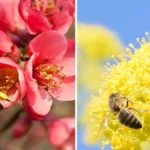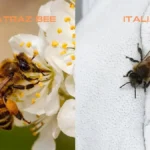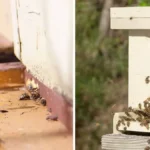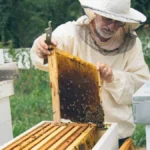In this article we take a look at Carniolan honey bees vs Italian honey bees – the two most commonly farmed races of bees. Both are excellent bees and have advantages and disadvantages that are good to keep in mind when choosing your bees.
Italian bees are the most commonly kept commercial race of bees, and Carniolan bees are the second. It can be a bit bewildering deciding which bees to choose. But armed with the knowledge in this article you can make a decision.
Bees have naturally evolved into races around the world, much like we have as humans. Different races are differently adapted to thrive in local conditions. Italian bees come from a moderate Mediterranean climate. Carniolan bees come from a colder continental climate zone. The original climate from whence the bees came influences their character significantly.
Carniolan Bees – A Quick Introduction
This bee is found naturally in Slovenia, Croatia, Serbia, Romania, Bulgaria, and Bosnia Herzegovina. It is farmed extensively throughout Europe and North America. The Carniolan bee is well adapted to climates where there is a prolonged cold winter. The bees form a dense cluster that consumes hive stores efficiently.
They are Tracheal mite resistant and are generally gentle and easy to work with. They are in fact so calm that Romi beekeepers are able to pull bee carts by horse. Bees hate horses, and you need a very gentle bee that can enable this scenario.
Italian Bees – A Quick Introduction
The Italian bee or Apis mellifera ligustica in its scientific Latin name is actually the Latin bee. It originated at what was the heart of the Roman Empire in Italy. This bee has been farmed for thousands of years. Pliny the Elder who lived about 2000 years ago wrote extensively about the Italian bee. Pliny combined a mixture of wisdom and some weird stuff that would probably both help and hinder apiculture for millennia.
Italian bees were also used in military campaigns by the Romans using catapults to fling hives into enemy fortifications. Hence this rather clever militarisation of bees helped the Italian bee spread its range in Europe.
If we fast forward to the current time, and airplanes and ships have allowed Italian bees to spread around the world. They range from Australia to New Zealand, China, the Americas, India, and even little Islands such as Mauritius. The bees were introduced extensively in Africa to “improve” the local bees but very little trace of their genes remains on the continent. They are no match for African bees.
Read more about: What Are K Wing Bees?
Carniolan Honey Bees vs Italian Honey Bees
Honey Production
Both bees are heavy honey producers, with the Italian bee probably being slightly more associated with world records in honey per hive. Carniolan bees are generally regarded as slightly lower honey producers in warmer climates than Italian bees. If you are in a colder climate, the Carniolans will outperform Italian bees.
Swarming
Italian bees are generally less prone to swarming than Carniolans. This is one of the main factors impacting honey production – swarm losses lower honey yields.
Defensiveness
Both races of bees are pretty gentle – Carniolans more so generally. This will also depend on where you source your queens. I have worked very angry Italian and Carniolan hives, and I have worked hives of both races that were stupidly peaceful.
Drifting
Italian bees are far more prone to drifting. If you place your bees in lines (as most people do in apiaries) you will find that you get drifting to certain hives that then become really strong. With Italian bees, this can become a problem and lead to some very strong hives and some very weak hives.
Disease Resistance
Italian bees in the general sense of the lighter bee widely available in the US have relatively poor mite resistance. Carniolans have somewhat better mite resistance.
Italian bees were noted by brother Adam to have a high susceptibility to Tracheal mites for the lighter strains and far lower susceptibility for the darker strains. Generally, Italian bees are far less resistant to Varroa than Carniolans. There are a few isolated reports of Italian bees surviving without varroa treatment – such as this example in Brazil.
Carniolan bees are effective at biting the legs of varroa mites. Conveniently, this leads to the mites falling to the bottom of the hive and becoming incapacitated. This trait is quite interesting and shows rapid adaptation to a new parasite.
Overwintering
Italian bees are adapted to live in a relatively mild climate. They can overwinter in a snowy environment, but they do not fully shut their brood nests down. This means they consume large quantities of honey in colder climates. Consequently, they are not suited to extremely cold climates as they lack the evolutionary adaptation to overwinter successfully through a harsh winter.
In colder climates, Italian bees can rear brood and actually run out of pollen stores. As a result of this, it causes hive malnourishment and can cause collapse. It is also important to remember that, as with us, bees have to poop if they eat. Hence if bees are eating pollen to rear brood they need to perform “cleansing” flights. If they “cleanse” in the hive it will become an unhygienic mess.
Carniolans are far more suited to colder climates and form a tight efficient winter cluster that consumes honey stores relatively slowly. They are able to increase bee populations explosively in spring. These bees are efficient at managing brood levels in relation to nectar availability.

How To Choose Between Carniolan Bees vs Italian Honey Bees
Taking the above into account, if you are in an area with long snowy cold winters, then choose Carniolans. However, if you have a milder more Southern, or Coastal climate, Italian bees seem a better choice. My general advice would be to contact local beekeepers in your area. Find out which bees do the best in your area. From here you can make a choice and move from there.
Both Italian and Carniolan bees are generally excellent choices of bees and should give you great joy working them. If you cant make up your mind, just take the plunge and start with whatever you can get. With time and experimentation, you can learn what works best for you.
We hope this article has helped you understand the differences between Carniolan honey bees vs Italian honeybees. If you enjoyed the article please share.
Read more about: Carniolan vs Russian Bees

Dr. Garth A. Cambray is a Canadian/South African entrepreneur and beekeeper with 28 years of experience in apiculture and specializes in adding value to honey. His Ph.D. research developed a new advanced continuous fermentation method for making mead that has resulted in a number of companies globally being able to access markets for mead. His company, Makana Meadery, exports honey mead to the USA where it is available to discerning connoisseurs. He has also developed technologies to commercially manufacture organic honey vinegar in Zambia for export globally. He holds a few patents globally in the ethanol industry and believes in technology and knowledge transfer for human development and environmental sustainability. One of his proudest achievements is the fact that the wind farm he started at one of his old apiary sites has essentially made his hometown carbon neutral.






